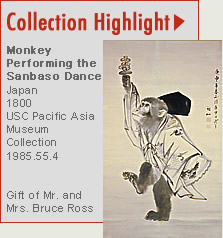Pacific Asia Museum
Pasadena, California 91101
Open Wednesday through Sunday 10am to 6pm

Korean Funerary Practices in Comparison with Chinese
As the mingqi reveal a once dominant Chinese burial practice (explained in an earlier audio stop), white porcelains and the tomb guardian seen here also teach us about funerary practices and values in Korean society. As Confucianism replaced Buddhism in the Joseon dynasty, filial piety, one of the virtues in Confucian teachings, greatly influenced daily life. This idea extends to the afterlife; highest respect for deceased parents was regarded as a continuing act of filial piety, thus ensuring their ongoing blessings and guidance.
Family members didn’t spare any resource when preparing funerary services and tombs for their ancestors, which were seen to be demonstrations of how dutiful they were to their ancestors. Those tombs had earthen mounds, tombstones and/or funerary statues such as this one, depending on the family’s social standing and wealth. Rituals for the ancestors also took place regularly, and conducting proper rituals in the correct order and with appropriate ritual wares were equally important to arranging proper funerary services and tombs. White porcelains such as the examples in this case were specifically made as part of rituals for ancestors. For more information on Chinese burial ceramics or mingqi, please visit the museum’s Snukal Ceramics Study and Silk Road Galleries.


 Instagram
Instagram